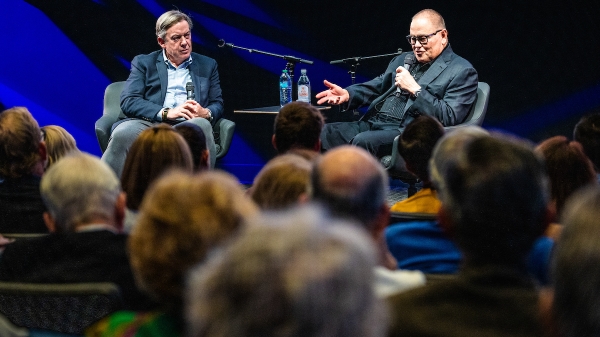Space innovations: ASU research enhances astronaut productivity, team dynamics

An image of the International Space Station was photographed by one of the crewmembers of the STS-105 mission from the Shuttle Orbiter Discovery after separating from the station in 2001. Photo courtesy of NASA
Astronauts working on the International Space Station adhere to strict daily schedules that include exercising, performing ship maintenance and conducting research and experiments. But frequently switching between tasks increases the likelihood of making a mistake, which can be fatal in space.
"Research shows that when a person switches their attention to a new task, they are often distracted by thoughts related to the first task," says Jeff LePine, professor of management and PetSmart Chair in Leadership at Arizona State University's W. P. Carey School of Business.
This mental state, called attention residue, increases the likelihood of making mistakes and can lead to decreased engagement in tasks throughout the day.
LePine, who was elected an Academy of Management Fellow this summer for his significant contributions to the science and practice of management, recently concluded an eight-year NASA research project investigating task entrainment, or how people remain psychologically tethered to a prior task when transitioning to a new task.
He specifically studied how engagement in a prior task impacts engagement and performance in the subsequent task, or residual engagement, and explored ways to mitigate the negative effects of attention residue.
LePine recommends doing things to mitigate the negative effects of task attention residue, like completing a task before moving on to something new.
"The more complete a task is, the less likely it is that you will think about the task when transitioning to something new," he says.
He also noted that taking short breaks may be beneficial because work breaks help people recover energy, but taking longer breaks can have a negative effect because it can reduce the degree to which the positive feelings engendered from working on a task can spill over to enhance engagement in the next task.
While LePine's research focused primarily on maintaining and improving the motivation and task effectiveness of people working in isolated environments like the ISS, his findings can be applied to improving task management and engagement in the classroom, the boardroom and the office.
The positive — and negative — effects of task-switching
LePine began working on the NASA project "Understanding and Preventing Crew Member Task Entrainment" as a principal investigator in 2015 alongside Associate Professor of management and entrepreneurship Ned Wellman and doctoral student Daniel Newton, now an associate professor at the University of Iowa. Originally a three-year grant, NASA extended the project several times before LePine completed the research last December.
Before testing their residual engagement theories and collecting data from astronauts aboard the ISS, the team recruited ASU undergraduate students and astronauts working at NASA's Houston-based Human Exploration Research Analog, or HERA, which simulates isolated environments similar to the ISS for behavioral and mission exploration research, as test subjects. LePine's team then began to apply what they learned to understand how to sequence tasks during the day to maximize engagement and performance.
"We reasoned that because there is a positive spillover of engagement from one task to the next, even after attention residue is considered, it may be possible to sequence tasks to capitalize on this compounding of engagement over the course of the day to, in essence, design days that are more engaging relative to days where tasks are scheduled more haphazardly," LePine says. "How meaningful a task is to a person is the primary driver of engagement, so we sequenced tasks with respect to this task characteristic."
The team then began implementing their theories with crew members working at the Nazemnyy Eksperimental’nyy Kompleks Mars training facility in Moscow and HERA. Since the team wasn't able to adjust the daily schedules of astronauts aboard the ISS for research purposes, astronauts were instead asked to reflect on their experiences transitioning between tasks in three weekly self-assessments and participated in exit interviews with the team after returning to Earth.
The team also tested their theories with undergraduate students, who were asked to perform several tasks that required varying levels of engagement — creating an expense report, building a company logo out of Legos, creating an Instagram marketing post and addressing envelopes — in different orders and were assessed on how the order of activities, and their engagement in each activity, affected their overall engagement across all four tasks.
LePine’s team also studied 132 employees with flexible daily work schedules. The team contacted these individuals each morning for three weeks and asked them to structure their daily tasks such that on some days they performed their most meaningful tasks at the beginning, end or middle of the day. Workers then completed daily self-assessments on how motivated or engaged they were, and how well they performed, based on their task workflows.
LePine's research determined that people — whether they are astronauts, office workers or graduate students — almost always experience residual engagement when task-switching, which affected their task engagement and effectiveness, but were more engaged and productive when completing their most engaging tasks earlier in their task sequence.
"People who concentrated their most meaningful tasks earlier in the day experienced the most compounding of engagement throughout the day. The engagement was restorative and made people feel more energetic," says LePine. "NASA was originally interested in the negative aspects of entrainment, but we found that how you structure your daily tasks has a significant impact on whether you experience a higher or lower level of engagement across all the tasks performed during the day.”
The team then investigated how anticipating future tasks impacts a person's ability to concentrate on current tasks.
"In our interviews with astronauts on the ISS, there were occasions when they were thinking ahead to future tasks that distracted them from the present task," says LePine. This mental state, which LePine’s team referred to as “anticipatory engagement,” had a weaker effect on a person's engagement in a present task, relative to residual engagement.
Studying large team dynamics
LePine is also two years into a $2 million grant studying multiteam systems, or large teams made up of smaller teams. The project is in partnership with labs at Michigan State and Penn State, and funded by the Army Research Institute and Office of Naval Research. The research will be used to help the military better understand short-term problems that involve multiteam efforts, like wars or rescue missions.
Since multiteam systems can be comprised of dozens of people who are geographically dispersed, they are challenging to study. The project's goal is to establish a national infrastructure to study multiteam systems while observing the effects of diversity, structure and other factors within multiteam systems.
LePine says studying multiteam systems posed a challenge since it was difficult to do in the field and it was unlikely that any single university had enough student volunteers to test multiteam systems multiple times a week in a lab setting.
To overcome the challenge, LePine, alongside principal investigators John Hollenback and Steven Humphries from Michigan State, use a multiteam system version of a video game called LDX that simulates a large multiteam structure that can be played by students at all three schools at the same time.
LDX breaks students into three component teams that perform various roles such as intelligence, operations and leadership — and requires students to work together to solve problems by interacting and coordinating responses to opportunities and threats while adjusting to communication breakdowns.
LePine, Hollenback and Humphries then collect behavioral data on the students' experiences through self-assessments while accounting for how other factors, like gender, affect the team's communication and problem-solving abilities.
The simulation is also helping LePine study imagined interactions that affect a person's stress levels and task engagement. Through his NASA research, LePine determined that anticipatory engagement didn't significantly affect a person's ability to engage in a task, but imagined interactions that involve a colleague or supervisor had a profound effect on the subject.
"Anticipating future tasks wasn't distracting, but anticipating future interactions with people is very distracting because human interaction can be uncertain, dynamic and very important," LePine says. "This is one of the first studies looking at the effects of imagined scenarios in work-related interactions.
"We found that when it comes to work, imagining scenarios actually increases people's social anxiety because the unknowns become more apparent, but it also helps people increase their perspective-taking. People who engage in imagined interactions are rated as being more effective interpersonally by their peers."
LePine says the benefits of projects like this multisystem grant go far beyond research to better understand interpersonal relationships: The funded research creates ample opportunities for students to get involved with academia and have a hands-on learning experience.
"Research like this presents opportunities for students to not only collect data and publish their findings but also connect with peers and faculty from other institutions," LePine says. "To me, the biggest advantage of this research is that it provides a venue for students to research topics that interest them and are also important to business and society."
More Business and entrepreneurship

Scrappy, adaptive, inventive: A fireside chat with GoDaddy’s Bob Parsons
GoDaddy founder, Vietnam War Marine veteran and New York Times bestselling author Bob Parsons joined Arizona State University President Michael Crow for a fireside chat at ASU’s MIX Center in Mesa on…

Why consumers are flying high this holiday season
A few years ago, the airline industry was in serious trouble.The COVID-19 pandemic crippled travel, and U.S. airlines received $54 billion in taxpayer bailouts, according to the U.S. Department of…

Being kind with in-kind donations
Charities and nonprofits with retail stores must walk a fine line when accepting in-kind donations from the public.If they turn away items they can’t use, they could appear ungrateful. But if they…
